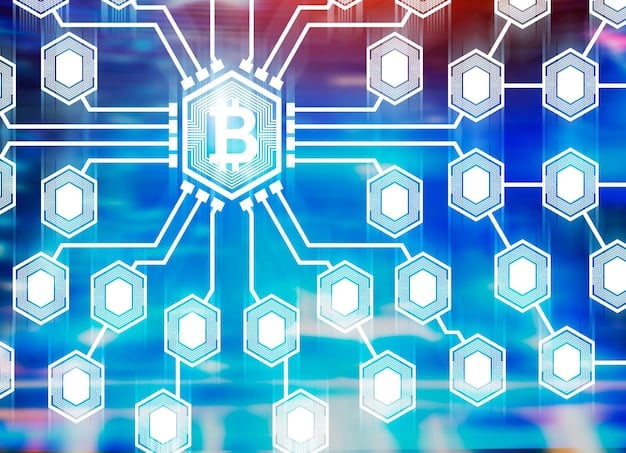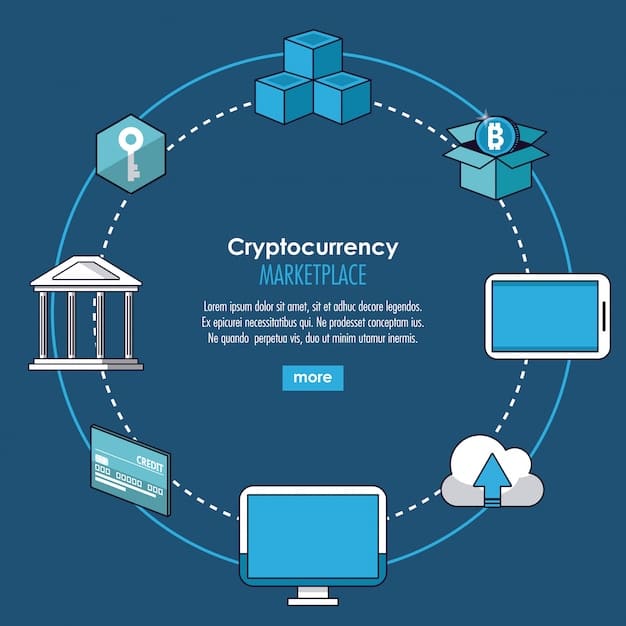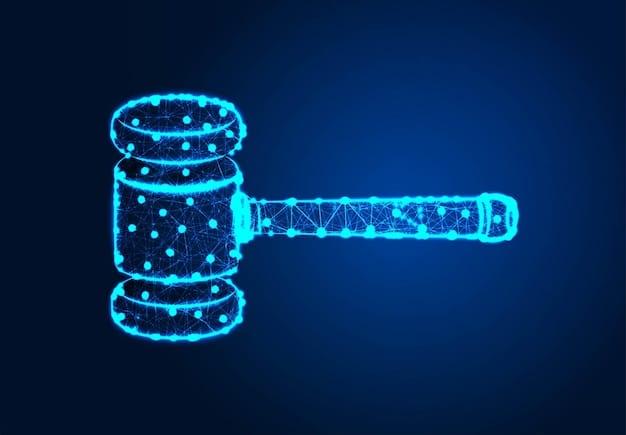Blockchain IP Protection: US Guide to Secure Digital Assets

Blockchain intellectual property protection in the US involves using blockchain technology to secure digital assets and prevent copyright infringement by creating immutable records of ownership and licensing, ensuring transparency and traceability of intellectual property rights.
In today’s digital age, protecting intellectual property (IP) is more challenging than ever. With the rise of blockchain technology, a new frontier of solutions is emerging to address these challenges. Blockchain intellectual property protection offers innovative ways to secure digital assets and prevent copyright infringement in the US, providing creators with enhanced control and transparency over their work.
Understanding the Basics of Blockchain and Intellectual Property
Blockchain technology, initially known for cryptocurrencies, has broader applications in various sectors, including intellectual property. Understanding how blockchain works is crucial to grasp its potential in safeguarding digital assets.
What is Blockchain?
Blockchain is a decentralized, immutable ledger that records transactions across many computers. Each transaction, or “block,” is linked to the previous one, forming a chain, which makes it resistant to tampering.
- Decentralization: No single entity controls the network, reducing the risk of censorship or manipulation.
- Immutability: Once a block is added to the chain, it cannot be altered, ensuring data integrity.
- Transparency: All participants can view the blockchain, although the identities of users are often anonymized.
The intersection of blockchain and intellectual property introduces novel methods for verifying ownership and managing rights efficiently. This is especially relevant given the increasing importance of digital assets in today’s economy.
How Blockchain Enhances Intellectual Property Protection
Traditional methods of intellectual property protection often involve complex legal processes and centralized databases. Blockchain offers a streamlined and secure alternative, enhancing various aspects of IP rights management.
Digital Asset Registration
Blockchain can be used to register digital assets, creating a permanent record of ownership. This can include artwork, music, software, and patents. The registration process typically involves hashing the asset and storing the hash on the blockchain.

Smart Contracts for Licensing
Smart contracts are self-executing contracts with the terms written directly into code. They can automate the licensing process, ensuring that rights holders receive royalties whenever their work is used.
- Automated Royalties: Smart contracts can automatically distribute royalties to rights holders based on pre-defined terms.
- Usage Tracking: Blockchain can track how and where digital assets are being used, providing valuable data for rights enforcement.
- Transparency: All licensing terms and transactions are recorded on the blockchain, ensuring transparency for all parties involved.
By leveraging blockchain, creators can have greater control over their intellectual property rights, reducing the reliance on traditional intermediaries and legal battles.
Preventing Copyright Infringement with Blockchain
Copyright infringement is a significant concern for digital creators. Blockchain offers several mechanisms to prevent and address unauthorized use of copyrighted material.
Timestamping and Ownership Verification
By timestamping digital assets on the blockchain, creators can establish a verifiable record of when their work was created. This can be crucial in copyright disputes, providing evidence of prior existence.
Decentralized Content Distribution
Blockchain-based platforms can facilitate decentralized content distribution, allowing creators to sell their work directly to consumers without intermediaries. This reduces the risk of piracy and ensures that creators receive fair compensation.
Blockchain provides tools for monitoring and addressing copyright infringement issues. It creates a secure and transparent ecosystem where creators can protect their rights effectively.
Legal Considerations for Blockchain-Based IP Protection in the US
The legal landscape surrounding blockchain and intellectual property is still evolving. Understanding the current legal considerations in the US is essential for creators and businesses using blockchain for IP protection.
Copyright Law and Blockchain
US copyright law protects original works of authorship, including literary, dramatic, musical, and certain other intellectual works. Blockchain can provide a means of proving ownership and tracking usage, which can be valuable in copyright infringement cases.

Patent Law and Blockchain
Patents protect inventions, and blockchain can be used to secure and manage patent rights. By registering patents on a blockchain, inventors can create a verifiable record of their inventions and track their licensing.
- Provisional Patents: Blockchain can timestamp and store provisional patent applications, providing early evidence of inventorship.
- Patent Licensing: Smart contracts can automate the licensing of patents, ensuring that inventors receive royalties and that licensees comply with the terms of the license.
Navigating the legal framework requires careful consideration of existing laws and how they apply to blockchain-based IP protection systems. Consulting with legal experts is advisable.
Challenges and Limitations of Blockchain IP Protection
While blockchain offers promising solutions for intellectual property protection, it is not without its challenges and limitations. Understanding these issues is critical for implementing effective blockchain-based IP strategies.
Scalability Issues
Some blockchain networks have limited scalability, which can affect the speed and cost of transactions. This can be a barrier for registering large numbers of digital assets on the blockchain.
Regulatory Uncertainty
The regulatory landscape surrounding blockchain is still evolving, and there is uncertainty about how existing laws will apply to blockchain-based IP systems. This can create legal risks for creators and businesses.
Addressing these challenges requires ongoing innovation and collaboration among technologists, legal experts, and policymakers to develop robust and reliable blockchain-based IP protection solutions.
The Future of Blockchain and Intellectual Property Rights
The future of blockchain and intellectual property rights is promising, with ongoing developments and increasing adoption across various industries. As blockchain technology evolves, it is expected to play an even greater role in securing digital assets and preventing copyright infringement.
Decentralized Autonomous Organizations (DAOs)
DAOs are blockchain-based organizations that operate autonomously based on coded rules. They can be used to manage intellectual property rights collectively, allowing creators to collaborate and share revenue more efficiently.
Non-Fungible Tokens (NFTs)
NFTs are unique digital assets that represent ownership of a specific item or piece of content. They can be used to tokenize intellectual property rights, allowing creators to sell or license their work on blockchain-based marketplaces.
With continued advancements and growing acceptance, blockchain is set to transform how intellectual property is protected, managed, and monetized in the digital age.
| Key Point | Brief Description |
|---|---|
| 🔑 Digital Asset Registration | Using blockchain to create a permanent ownership record for digital assets. |
| 🤖 Smart Contracts for Licensing | Automated agreements that ensure rights holders receive royalties. |
| 🛡️ Preventing Copyright Infringement | Mechanisms to address unauthorized use of copyrighted material. |
| ⚖️ Legal Considerations | Understanding US copyright and patent laws in the context of blockchain. |
Frequently Asked Questions
▼
Blockchain is a decentralized, immutable ledger that records transactions across multiple computers, ensuring data integrity and transparency. It’s commonly used for cryptocurrencies and intellectual property protection.
▼
Blockchain helps protect IP by creating permanent records of ownership, timestamping digital assets, and automating licensing through smart contracts. This enhances transparency and reduces copyright infringement.
▼
Smart contracts are self-executing contracts with the terms written into code. They automate processes like royalty distribution and usage tracking, ensuring all parties adhere to the agreed-upon terms.
▼
In the US, understanding copyright and patent laws is crucial when using blockchain for IP protection. Consult legal experts to ensure compliance with existing regulations and to navigate evolving legal interpretations.
▼
Limitations include scalability issues and regulatory uncertainty. Some blockchains may struggle with large volumes of transactions, and the evolving legal landscape can create risks for blockchain-based IP systems.
Conclusion
In conclusion, blockchain intellectual property protection offers innovative solutions for securing digital assets and preventing copyright infringement in the US. By understanding its potential, legal considerations, and limitations, creators and businesses can leverage blockchain to enhance IP rights management in the digital age.





